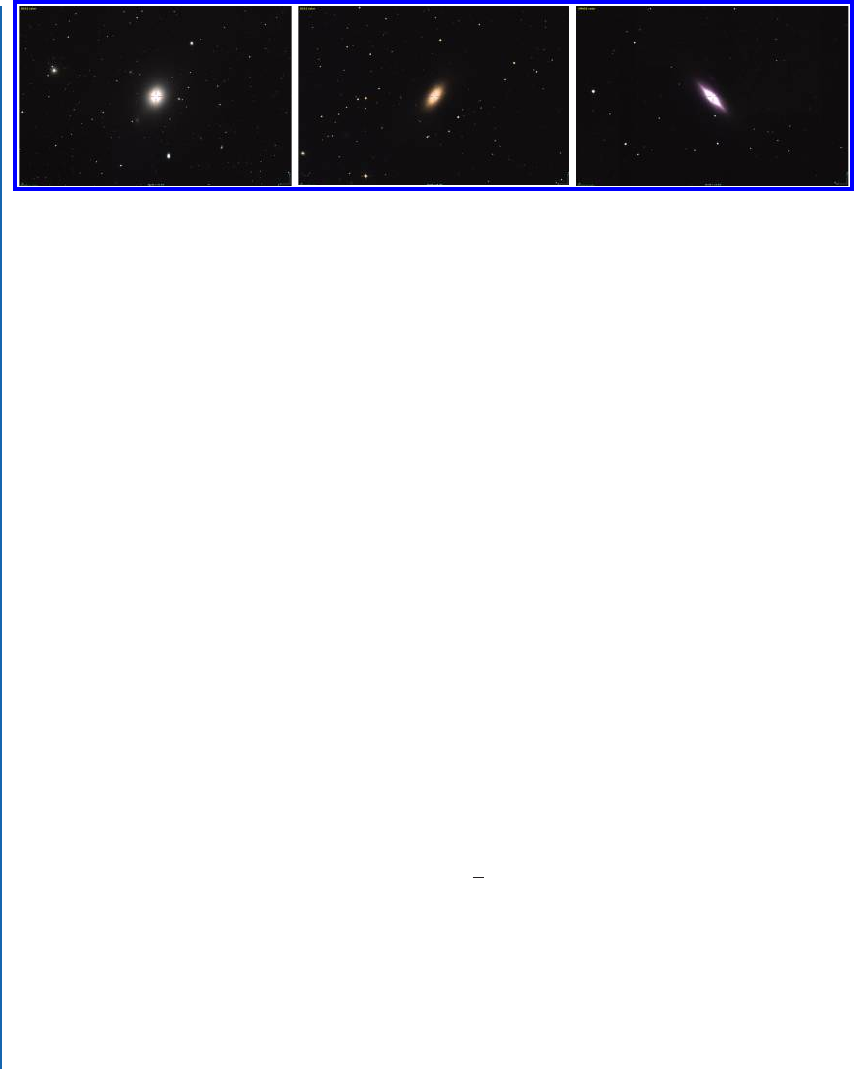
226 16. THE STRUCTURE OF GALAXIES
Figure 16.1: From left to right: M 49, NGC 720, and NGC 3115. e first two are elliptical
galaxies (types E2 and E6, respectively), while NGC 3115 is really a lenticular, or S0, galaxy—a
type intermediate between elliptical and spiral galaxies. (Images made with the Aladin sky atlas.
DSS2; Bonnarel et al. [2000], Lasker et al. [1996].)
One concern is the morphology of the galaxy—its apparent shape, either as literally imaged
in a telescope or as a best estimate of how it would appear if it could be seen in three dimensions
from different angles [Binney and Merrifield, 1998, Chap. 4]. As we shall see, there are pat-
terns to the morphology of galaxies; some features tend to go with others. But there are other
concerns apart from morphology. Does the galaxy have an active nucleus, and if so what kind?
Is a particular galaxy perhaps a special case of a particular kind of interaction with other galaxies,
or might it be a brief happenstance interval in the evolution of an individual galaxy?
16.1 ELLIPTICAL AND LENTICULAR GALAXIES
An ellipse is an oval shape with a precise mathematical curve. Despite the name, a typical ellip-
tical galaxy is only roughly in the shape of an ellipse [Binney and Tremaine, 1987, p. 21]. For
one thing, there is no obvious edge; such a galaxy fades out, gradually becoming fainter as one
looks farther from its center. But for any chosen level of brightness, elliptical galaxies appear
with shapes between that of a sphere and an elongated oval, diminishing smoothly in brightness
from the center, and with no clear sign of gas or dust.
If we divide the shortest dimension, b, of an elliptical galaxy by its longest, a, we can
categorize it by its apparent shape. An elliptical galaxy has type En, where n is a number rounded
off from:
n D 10
1 ´
b
a
: (16.1)
And so an E0 galaxy appears circular and has b=a D 1, while an E7 galaxy has has a long axis
that is over three times its short axis (b=a D 0:3). See the first two images in Figure 16.1 for
examples of E2 and E6 galaxies.
e most elongated elliptical galaxies are E7. ere are galaxies more elongated than this,
and that otherwise look like ellipticals; they seem to be made entirely of stars and vary smoothly
in brightness, with no evidence of gas or dust. But their shape deviates markedly from an ellipse,
..................Content has been hidden....................
You can't read the all page of ebook, please click here login for view all page.
